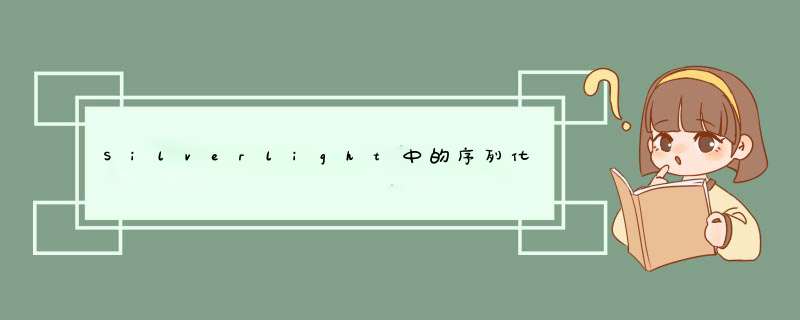
序 列化简言之是这样一种能力:能够把复杂的对象(Object)变成某种格式的字符串(常见的格式有xml,string,二进制文件等),这样可以方便的 在各种系统中传输或交换(比喻socket编程中的数据包只能用byte[]传输),接收方得到该字符串后,通过反序列化可以还原为复杂对象,进而调用对 象的方法或属性 -- 跟反射有点沾边:)
这里先给出一个WinForm的序列化例子,功能为通过打开文件对话框选择一个文件后,构造一个复杂对象,然后序列化为二进制格式,得到该格式后,再反序列化(还原)为复杂对象
Winform中的序列化
1 using System;
2 using System.IO;
3 using System.Runtime.Serialization;
4 using System.Runtime.Serialization.Formatters.Binary;
5 using System.Text;
6 using System.windows.Forms;
7
8 namespace SerializeStudy
9 {
10 public partial class Form1 : Form
11 {
12 public Form1()
13 {
14 InitializeComponent();
15 }
16
17 private voID btnSerialize_Click(object sender,EventArgs e)
18 {
19 OpenfileDialog opendlg = new OpenfileDialog();
20 if (opendlg.ShowDialog() == DialogResult.OK)
21 {
22
23 #region 得到一个包含"文件内容"的Msg对象
24 Msg msg = new Msg();
25 msg.Receivername = "jimmy";
26 msg.Sendername = "yjmyzy";
27 msg.Type = MessageType.file;
28 fileStream fs = opendlg.Openfile() as fileStream;
29 msg.Body = new byte[fs.Length];
30 fs.Read(msg.Body,msg.Body.Length);
31 fs.Close();
32 #endregion
33
34 #region 将Msg对象序列到内存流中
35 MemoryStream ms = new MemoryStream();
36 BinaryFormatter binaryFormatter = new BinaryFormatter();
37 binaryFormatter.Serialize(ms,msg);
38 #endregion
39
40 #region 再将内存流转化为byte[]
41 byte[] arrMsg = ms.ToArray();
42 ms.Close();
43 #endregion
44
45 MessageBox.Show("序列化成功!");
46
47 StringBuilder sb = new StringBuilder();
48
49 for (int i = 0; i < arrMsg.Length; i++)
50 {
51 sb.Append(arrMsg[i].ToString() + ",");
52 }
53
54 textBox1.Text = sb.ToString().Trim(',');
55 }
56 }
57
58 private voID btnDeSerialize_Click(object sender,EventArgs e)
59 {
60 if (textBox1.Text.Trim().Length == 0) { return; }
61
62 #region 先将textBox1中的内容变成byte[]
63 string[] arrMsg = textBox1.Text.Trim().Split(',');
64 byte[] arrBin = new byte[arrMsg.Length];
65
66 for (int i = 0; i < arrMsg.Length; i++)
67 {
68 arrBin[i] = byte.Parse(arrMsg[i]);
69 }
70 #endregion
71
72 try
73 {
74 IFormatter formatter = new BinaryFormatter();
75 MemoryStream ms = new MemoryStream(arrBin);
76 Msg msg = formatter.Deserialize(ms) as Msg;
77
78 if (msg != null)
79 {
80 MessageBox.Show("反序列化成功!" + msg.Receivername + "," + msg.Sendername + "," + msg.Type);
81 }
82
83 }
84 catch (Exception ex)
85 {
86 MessageBox.Show(ex.Message.ToString());
87 }
88 }
89 }
90
91
92
93 /// <summary>
94 /// 消息格式
95 /// </summary>
96 [Serializable]
97 public enum MessageType
98 {
99 txt,
100 img,
101 file,
102 unkNown
103 }
104
105 /// <summary>
106 /// 消息对象
107 /// </summary>
108 [Serializable]
109 public class Msg
110 {
111 private MessageType _type = MessageType.unkNown;
112 public MessageType Type
113 {
114 set { _type = value; }
115 get { return _type; }
116 }
117
118 public string Sendername { set; get; }
119 public string Receivername { set; get; }
120 public byte[] Body { set; get; }
121
122 }
123 }
124
不过在Silverlight中,传统的序列化方式有很多被精减掉了(比如BinaryFormatter之类),唯一得以保存的只剩下 System.Xml.Serialization,所以SL中只能通过xml来序列化对象(虽然xml序列化后的字节数相对Binary有点大,不过我 们也别无选择),另外有一点很让人不习惯的是,需要序列化的自定义类中,居然不需要加[Serializable],[DataMember]这类标记! (这一点让我郁闷了好久,还为此在网上疯狂的百度,Google为啥sl中不识别Serializable)
1.先定义一个需要序列化的类
自定义类
namespace SerializeDemo
{
/// <summary>
/// 聊天室消息对象
/// </summary>
public class ChatMessage
{
public string Sendername { set; get; }
public string Receivername { set; get; }
public MessageType Type { set; get; }
public byte[] Body { set; get; }
public enum MessageType {
txt,img,file,unkNown
}
}
}
2.序列化/反序列化代码示例:
Xaml部分:
Xaml
<UserControl x:Class="SerializeDemo.MainPage"
xmlns="http://schemas.microsoft.com/winfx/2006/xaml/presentation "
xmlns:x="http://schemas.microsoft.com/winfx/2006/xaml "
xmlns:d="http://schemas.microsoft.com/expression/blend/2008 " xmlns:mc="http://schemas.openxmlformats.org/markup-compatibility/2006 "
mc:Ignorable="d" d:DesignWIDth="640" d:DesignHeight="480">
<GrID x:name="LayoutRoot">
<GrID.RowDeFinitions>
<RowDeFinition Height="30"/>
<RowDeFinition Height="*"/>
</GrID.RowDeFinitions>
<StackPanel HorizontalAlignment="Center" OrIEntation="Horizontal">
<button x:name="btnSerialize" Content="序列化" WIDth="80" Height="24" Click="btnSerialize_Click"/>
<button x:name="btnDeSerialize" Content="反序列化" WIDth="80" margin="10,0" Height="24" Click="btnDeSerialize_Click"/>
</StackPanel>
<TextBox GrID.Row="1" Text="TextBox" textwrapPing="Wrap" d:LayoutOverrIDes="Height" x:name="txtResult"/>
</GrID>
</UserControl>
Xaml.cs部分:
Xaml.cs
using System;
using System.IO;
using System.Text;
using System.windows;
using System.windows.Controls;
using System.Xml.Serialization;
namespace SerializeDemo
{
public partial class MainPage : UserControl
{
public MainPage()
{
InitializeComponent();
}
private voID btnSerialize_Click(object sender,RoutedEventArgs e)
{
#region 得到一个复杂对象
ChatMessage msg = new ChatMessage();
msg.Receivername = "jimmy";
msg.Sendername = "yjmyzy";
msg.Type = ChatMessage.MessageType.file;
msg.Body = new byte[] { 0,1,1 };
#endregion
MemoryStream ms = new MemoryStream();
XmlSerializer xml = new XmlSerializer(typeof(ChatMessage));
try
{
xml.Serialize(ms,msg);//将对象序列化为流
byte[] arr = ms.ToArray();
StringBuilder sb = new StringBuilder();
for (int i = 0; i < arr.Length; i++)
{
sb.Append(arr[i].ToString() + ",");
}
txtResult.Text = sb.ToString().Trim(',');
}
catch (Exception ex)
{
txtResult.Text = ex.Message.ToString();
}
}
private voID btnDeSerialize_Click(object sender,RoutedEventArgs e)
{
if (txtResult.Text.Trim().Length == 0) { return; }
#region 先将txtResult中的内容变成byte[]
string[] arrMsg = txtResult.Text.Trim().Split(',');
byte[] arrBin = new byte[arrMsg.Length];
for (int i = 0; i < arrMsg.Length; i++) { arrBin[i] = byte.Parse(arrMsg[i]); } #endregion MemoryStream ms = new MemoryStream(arrBin); XmlSerializer xml = new XmlSerializer(typeof(ChatMessage)); try { ChatMessage msg = xml.Deserialize(ms) as ChatMessage;//反序列化为ChatMessage对象 if (msg != null) { txtResult.Text = "反序列化成功!" + msg.Receivername + "," + msg.Type.ToString(); } } catch (Exception ex) { txtResult.Text = ex.Message.ToString(); } } } }
总结以上是内存溢出为你收集整理的Silverlight中的序列化全部内容,希望文章能够帮你解决Silverlight中的序列化所遇到的程序开发问题。
如果觉得内存溢出网站内容还不错,欢迎将内存溢出网站推荐给程序员好友。
欢迎分享,转载请注明来源:内存溢出

 微信扫一扫
微信扫一扫
 支付宝扫一扫
支付宝扫一扫
评论列表(0条)